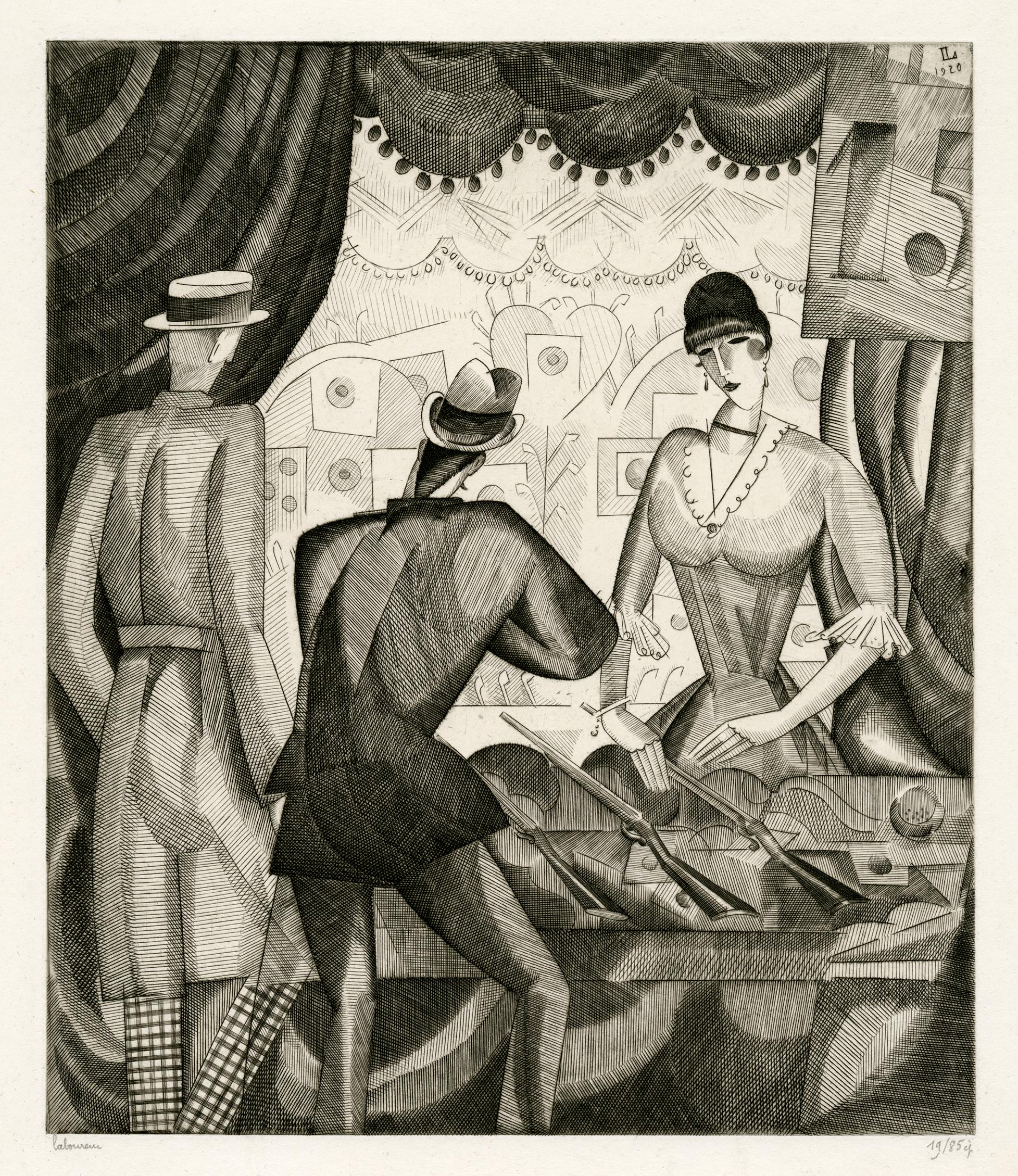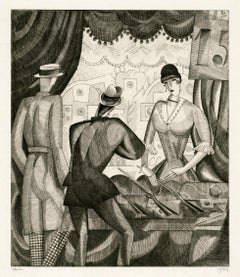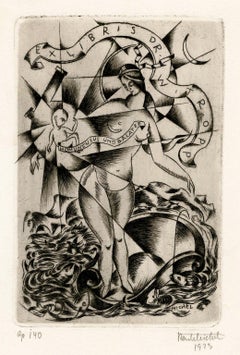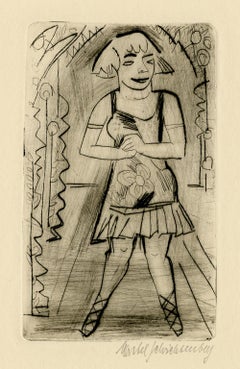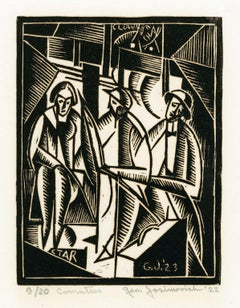Items Similar to La Receveuse (Bill Collector) —French Cubism
Want more images or videos?
Request additional images or videos from the seller
1 of 3
Jean-Emile LaboureurLa Receveuse (Bill Collector) —French Cubism1919
1919
$1,400
£1,068.17
€1,216.02
CA$1,967.72
A$2,163
CHF 1,135.56
MX$25,719.61
NOK 14,583.22
SEK 13,283.74
DKK 9,085.64
About the Item
Jean-Emile Laboureur, 'La Receveuse', engraving, 1919, edition 8, first state of two (artist's proof). Laboureur, Godefroy 190.
Signed and numbered '3/8 ép' in pencil. Initialed and dated '1918' in the plate. A fine impression, on cream laid paper, with full margins (1 1/4 to 1 1/2 inches), in excellent condition. Very Scarce in this state. Matted to museum standards, unframed.
ABOUT THE ARTIST
Born in Nantes in the summer of 1877, Emile Laboureur was the son of a prosperous bourgeois family. He went to Paris in 1895 to study law but found himself more often drawn to study at the famed art school Académie Julian, although he never officially enrolled there. Upon his introduction to the distinguished wood engraver Auguste Lepère, he decided to take up the formal study of printmaking.
Lepère’s technical instruction in the craft of printmaking was essential for Laboureur’s artistic initiation but provided little in the way of stylistic inspiration. It was Toulouse-Lautrec, with whom Laboureur had become socially acquainted in 1896, who liberated his sense of humor and allowed him to recognize the potentialities for the visual expression of wit and irony. Laboureur assimilated his own orthodox wood engraving and etching techniques with the convivial, cosmopolitan subject matter of Lautrec’s color lithographs. Concurrently, his work took increasing cognizance of other contemporary innovations: the baleful hallucinations of Odilon Redon; the serpentine curves and wry social observations of Pierre Bonnard; and, most importantly, the incisive black and white compositions of Félix Vallotton, whose influence stayed with Laboureur’s graphic works for twenty years.
By 1899, Laboureur had fulfilled his compulsory service with the military, which he despised, and was able to pursue his love of art full-time. Laboureur traveled extensively to study, work, and learn all there was about the history of engraving. He developed a vast knowledge and connoisseurship during his trips to Italy, Germany, and throughout Europe.
Laboureur traveled to the United States in 1903—the country and its people appealed to him enormously. He was intrigued by the frenzy of the great industrial capitals, by the spectacle of skyscrapers, by the conspicuous consumption of the monied classes, and equally by the urban proletariat. Among the cities he visited were Albany, Boston, New York, Newark, Philadelphia, and Pittsburgh. Pittsburgh captured his imagination and he produced two successful series based on the city – 'Ten Etchings from Pittsburgh' (1905) and 'In The Pittsburgh Mills' (1906). He would lecture wherever he went, especially in New York, under the name Jean-Emile.
Having stayed in London for a period, he finally settled in France for good by 1910. By that time analytical cubism had burst upon the art scene. Laboureur’s style, however, remained essentially unchanged for the next several years while he was digesting this new genre. By 1913, he began to invent a cubist vernacular that was distinctly his own, one that would rival Picasso, Villon, and Braque but one which was distinctly decorative rather than analytical.
With the outbreak of World War I, Laboureur was again enlisted in the military. This disruption to his artistic life necessitated a change in mediums. No longer able to produce etchings due to the bulky paraphernalia required for acid baths, he began to engrave his plates (which he often salvaged from an ammunition depot) directly with a portable burin. In 1916, he produced thirty-one engravings, among which was a series of nine published as ‘Petites images de la guerre sur le front britannique’. Their subject matter eschews the horror of war to focus on the absurd and comic aspects of the tragedy which engulfed Europe.
After the war, Laboureur turned increasingly to book illustration. He bought a house on the Breton coast and transformed himself from a bachelor bon-viveur into a country family man with two sons. He worked steadily during the 1920s, but due to the worldwide depression of the 1930s, his output began to lessen until 1939 when he was struck down by a disease that left him paralyzed and unable to work. His last two prints remain unfinished. He died in 1943.
Edited from: Robert Allen, ‘Jean-Emile Laboureur: A Centenary Tribute,’ Alliance Française, New York, 1977.
- Creator:Jean-Emile Laboureur (1877-1943, French)
- Creation Year:1919
- Dimensions:Height: 7.75 in (19.69 cm)Width: 5.82 in (14.79 cm)
- Medium:
- Movement & Style:
- Period:
- Condition:
- Gallery Location:Myrtle Beach, SC
- Reference Number:Seller: 1024601stDibs: LU53236696062
Jean-Emile Laboureur
Jean Émile Laboureur, born in Nantes on 16 August 1877 and died in Kerfalher in Morbihan on 16 June 1943, was a French painter, draughtsman, engraver, aquafortist, lithographer and illustrator. Author of numerous engravings with burin, in individual plates or for books, he illustrated nearly eighty books, often by contemporary authors such as André Maurois, Jean Giraudoux, Colette, André Gide, Paul-Jean Toulet, Maurice Maeterlinck or François Mauriac. A painter of genre paintings, landscapes, animated or not, still lifes, he also created some frescoes and sculptures. His works are kept in several national and provincial museums. He founded or chaired associations of independent artists.
About the Seller
5.0
Recognized Seller
These prestigious sellers are industry leaders and represent the highest echelon for item quality and design.
Platinum Seller
Premium sellers with a 4.7+ rating and 24-hour response times
Established in 1995
1stDibs seller since 2016
334 sales on 1stDibs
Typical response time: 1 hour
Associations
International Fine Print Dealers Association
- ShippingRetrieving quote...Shipping from: Myrtle Beach, SC
- Return Policy
More From This Seller
View All'Le Tir Forain' (Fairground Shooting) — 1920s French Cubism
By Jean-Emile Laboureur
Located in Myrtle Beach, SC
Le Tir Forain, engraving, edition 108, 1920-21, Sylvain Laboureur 191. Signed and numbered '19/85 ép' in pencil. Initialed 'L' and dated 1920 in the matrix,...
Category
1920s Cubist Figurative Prints
Materials
Engraving
'Ex Libris Dr. Witropp' — German Expressionism
By Karl Michel
Located in Myrtle Beach, SC
Karl Michel, 'Ex Libris Dr. Witropp - Homunculus und Galatee', etching, 1923, edition not stated. Signed, dated, and numbered 'Op. 140' (the artist's inventory number) in pencil. Si...
Category
1920s Expressionist Figurative Prints
Materials
Etching
'Varietesoubrette, Schwalbennest' also Dancer — 1920s German Expressionism
Located in Myrtle Beach, SC
Martel Schwichtenberg (1896-1945), 'Varietésoubrette, Schwalbennest (Variety Soubrette, Swallow’s Nest), drypoint, 1922. Signed in pencil. A fine, richly-inked impression; the full sheet of cream wove paper, with wide margins (3 3/4 to 5 1/4 inches), in excellent condition. Image size 7 3/16 x 4 5/16 inches; sheet size 16 3/8 x 12 1/8 inches. Archivally matted to museum standards, unframed.
Published in Die Schaffenden...
Category
1920s Bauhaus Figurative Prints
Materials
Drypoint
'Commuters' — Early 20th-Century Modernism
By George Josimovich
Located in Myrtle Beach, SC
George Josimovich, 'Commuters', linocut, 1922-23, edition 20. Signed, dated '22, titled, and annotated '9/20' in pencil. Initialed in the block 'G.J....
Category
1920s American Modern Figurative Prints
Materials
Linocut
Le Cheval (The Horse) — Mid-Century Cubism
By Léopold Survage
Located in Myrtle Beach, SC
Léopold Survage, 'Le Cheval' (The Horse), color etching, edition 60, 1953. Signed and numbered '46/60' in pencil. Initialed in the plate, lower right. A superb, richly-inked impressi...
Category
1950s Surrealist Figurative Prints
Materials
Etching
'Descente de Croix' (Descent from the Cross) — 1920s French Cubism
By Albert Gleizes
Located in Myrtle Beach, SC
Albert Gleizes, 'Descente de Croix', color pochoir, 1928, edition c. 50. Signed and dated in pencil. A fine, painterly impression, with fresh colors, on heavy, cream wove paper; the full sheet with margins (3 to 4 inches), in very good condition. The publisher's ink stamp 'EDITIONS MOLY-SABATA' beneath the image, lower left. Matted to museum standards, unframed.
Image size 12 x 14 inches (305 x 356 mm); sheet size 18 x 22 inches (457 x 559 mm).
ABOUT THE IMAGE
After the 1927 painting 'Descente de Croix', one of three religious-themed works that Gleizes developed as preliminaries for murals at the church at Serrières, France, the project was terminated at its final phase, and Gleizes commissioned master printer Robert Pouyaud to create prints of the paintings, closely overseeing the production.
ABOUT THE MEDIUM
Pochoir is a refined stencil-based technique employed to create multiples or to add color to prints produced in other mediums. Characterized by its crisp lines and rich color, the print-making process was most popular from the late 19th century through the 1930s, with its center of activity in Paris. The pochoir process began with the analysis of an image’s composition, including color tones and densities. The numerous stencils (made of aluminum, copper, or zinc) necessary to create a complete image were then designed and hand-cut by the 'découpeur.' The 'coloristes' applied watercolor or gouache pigments through the stencils, skillfully employing a variety of different brushes and methods of paint application to achieve the desired depth of color and textural and tonal nuance. The pochoir process, by its handcrafted methodology, resulted in the finished work producing the effect of an original painting, and in fact, each print was unique.
ABOUT THE ARTIST
Albert Gleizes (1881-1953), born in Paris, France, was a pioneering figure in the development of abstract art and one of the leading proponents of Cubism. His contributions to the art world extended beyond his paintings; he was also a prolific writer and theoretician, advocating for a new approach to art that emphasized the geometric abstraction of form and a departure from representational traditions.
Gleizes initially studied painting at the Académie Julian and the École des Beaux-Arts in Paris, where he was exposed to the academic conventions of the time. However, his artistic vision was profoundly influenced by encounters with avant-garde movements, including Fauvism and the work of Paul Cézanne. These influences led Gleizes to experiment with form and color, gradually moving away from traditional representation toward a more abstract and geometric style.
After completing his secondary schooling, Gleizes spent four years in the French army and then began pursuing a career as a painter, primarily doing landscapes. Initially influenced by the Impressionists, he was only twenty-one years of age when his work titled ‘La Seine à Asnières’ was exhibited at the Société Nationale des Beaux-Arts in 1902. The following year, he was part of the first Salon d'Automne and soon came under the influence of Fernand Léger, Robert Delaunay, Jean Metzinger, and Henri Le Fauconnier. In 1907, Gleizes and some of his friends pursued the idea of creating a self-supporting community of artists that would allow them to develop their art free of any commercial concerns. For nearly a year, Gleizes , with other painters, poets, musicians, and writers, lived at a large house in Créteil, but a lack of funds forced them to give up their facility in early 1908, and Gleizes moved temporarily into La Ruche, the artist commune in the Montparnasse Quarter of Paris.
In the early 1910s, Gleizes became associated with the Cubist movement, which was spearheaded by artists such as Pablo Picasso and Georges Braque...
Category
1920s Cubist Abstract Prints
Materials
Stencil
You May Also Like
La Receveuse
By Jean-Emile Laboureur
Located in New York, NY
Jean-Emile Laboureur (1877-1943), La Receveuse, engraving, 1919-1920, signed in pencil lower left, numbered (2/38) lower right and annotated ”imp” [also with initials and the date 19...
Category
1910s Cubist Portrait Prints
Materials
Engraving
La Fille au Litre (Grande Planche)
By Jean-Emile Laboureur
Located in New York, NY
ean-Emile Laboureur (1877-1943), La Fille au Litre (Grande Planche), engraving, 1921, signed in pencil lower left and inscribed “ep d’art”. Reference: Sylvain Laboureur 217, third st...
Category
1920s Cubist Portrait Prints
Materials
Engraving
Le Facteur Rural
By Jean-Emile Laboureur
Located in New York, NY
Jean-Emile Laboureur (1877-1943), Le Facteur Rural, engraving, 1924, signed in pencil lower right. Reference: Laboureur 283, third state (of 3), from the total printing of about 80. ...
Category
1920s Cubist Figurative Prints
Materials
Engraving
Sur la Marne
By Jean-Emile Laboureur
Located in New York, NY
Jean-Emile Laboureur (1877-1943), Sur la Marne, engraving, 1924, signed in pencil lower right [with the initial lower right in the plate]. Reference: S. Laboureur 277, third state (o...
Category
1920s Cubist Figurative Prints
Materials
Engraving
La Marchande de Violettes
By Jean-Emile Laboureur
Located in New York, NY
Jean-Emile Laboureur (1877-1943), La Marchande de Violettes, etching, 1914, signed in pencil lower left and numbered (33/35) lower right [also signed and dated in the plate lower rig...
Category
1910s Cubist Figurative Prints
Materials
Etching
Price Upon Request
La Fille aux Oies
By Jean-Emile Laboureur
Located in New York, NY
Jean-Emile Laboureur (1877-1943), La Fille aux Oies, engraving, 1916, signed in pencil lower left, numbered (4/40) lower right and inscribed “imp,” also titled lower left margin edge...
Category
1910s Cubist Figurative Prints
Materials
Engraving
More Ways To Browse
Salvador Dali Tree Of Knowledge
Sarah Slappey
Shag Josh Agle
Shepard Fairey Guns
Shield Of Achilles
Shigeki Kuroda
Simbari Sylvie
Sol Y Dali
Steffen Thomas
Steinberg Galerie Maeght Poster
Susan Rios Print
Swatch Keith Haring
Tan Tan Bo
Tarkay Serigraphs Signed
Tarot Card Box
Thank You For The Wonderful Destiny
The Emperor Jones
The Goddess Dali
